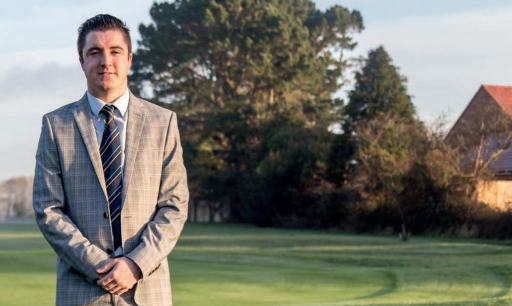There can’t have been too many younger secretaries when James Maclean assumed the role at Bognor Regis at the age of 23. Now general manager, and still only 27, he talks to Steve Carroll about acceptance, and becoming southern region GCMA captain…
How long have you been in post?
I’ve been general manager since January 2017 but I did four years as club secretary before that, which was effectively the same role except I was on a level with our food and beverage manager and, initially, on a level with the head greenkeeper and coordinating between us all.
A year into the post as secretary, I took on the golf course and management responsibility for the head greenkeeper. When I became general manager, I took on management responsibility for the food and beverage as well.
You’re 27 now, and became secretary at 23. You must have been one of the youngest secretaries around?
I must have been but it was never confirmed. It was just an assumption. I started going to GCMA events in October 2012 and it was a bit different – being the youngest there by quite a few years. It was quite strange.
How did the role come about?
I sort of fell into it, to be honest. I actually worked in the pro shop first. I wasn’t a pro but I worked there from 16. I was doing A-Levels at the time, the assistant pro left and the pro asked me if I wanted to work full-time for him – with a view to doing my PGA qualifications at some point.
I did five years for him and did the first year coaching course as a volunteer with the PGA. I didn’t give up my amateur status and decided this wasn’t the route I wanted to go down longterm. I didn’t really enjoy teaching, to be honest. It was a bit different at Bognor Regis too. The general manager before me left in 2009 and the club didn’t replace him. The club was losing members year on year, losing money year on year. We lost a substantial amount of money over a six to eight year period.
That was frustrating for me, from the pro shop point of view, and I was just trying to help out. I started doing competition results – running all the competitions and the handicaps – and then I progressed naturally to helping out with cover in the office while the assistant secretary was on holiday. Then the club said ‘right, how do you feel about carrying on that role?’ It was an evolution. I just fell into it. I didn’t intend – or sit there at school saying ‘I’m going to be a golf club manager one day’. At school, the dream was to be a PGA pro.
That gradual transition will have removed some of the concerns you might have had taking the role: would the members think I was too young, for instance…
If I’d just been brought in off the street, well, it would never have happened. There’s no way a private members’ golf club, even now, would just take on a 23-year-old as their secretary with no prior experience.
Was it a good way of doing it, though? You have had to prove yourself at every level and succeed at every level…
The club showed a lot of faith in me by giving me the opportunity. It was difficult but it was probably the only way to do it, because as I just said, I probably wouldn’t have got that opportunity any other way. I had to fall into it, and in the deep end if you like, to prove I could swim and be able to make it.
You get the position and have experience of each part of the job. But when things go wrong, which they do, how did you cope with that? I just tried to apply common sense. A lot of good management, in my opinion, is just common sense. It’s making a logical decision. Things go wrong and you’ve just got to run with it and try and do the best with it. I was lucky that I knew the team well and, when I worked in the pro shop, one winter I did a couple of months in the bar as well. I was part of the team, if you like, and I knew what was going on everywhere. It was just ‘get on with it’.
All the team were very supportive. They could have easily not been happy about having a 23-year-old in charge, and telling them what to do, but they were all fantastic.
Bognor are presumably a traditional club with committees and structures?
We were and we still are a private members’ club but, at the end of 2016, we incorporated and became a limited company. We now have a board and, to be honest, I was one of the main drivers, along with our finance director, for doing it. We had a management committee of 14 people and, at times, it was challenging to reach a decision on some issues. Having a board of five directors, who have been elected based on what they can bring to the table, has been fantastic.
When you first worked with that committee structure, did you experience a lot of support or was there some resistance – because you were young?
Generally, the support was fantastic. There may have been some people who needed to be convinced, but on the whole, everyone was very supportive.
Was that a difficult experience for you? You knew what was happening and I had a good sense of the people who were going to support me and the ones that were resistant. I imagine you also had a lot of support and goodwill as well?
Exactly. That was the good thing about a management committee of that many people. You had a good scope of people from across the whole club. I had a good sense that the members supported me. It wasn’t easy but I accepted it, and I knew it had to be that way, for me to progress in that career path. There was no way I would have got the job otherwise.
That kind of experience – both positive and negative – is key when you are the person trying to put through a management change as you did…
It took us over a year to get the process through but our finance director was on board with it and, obviously, the club’s management committee. They were all for it and could see the sense of it. I wrote a five-year strategy programme for the club and a key part of that strategy was ‘this is where we need to get to’ and we delivered it.
What difference has going to a board structure made?
It’s absolutely fantastic. It is much easier to talk about the accounts with only five or six people, as opposed to 14, and the decision making process is much easier and quicker. It’s so much better. I can’t rave enough about the change it has made. So when you go to meetings, every one is on point straight away… Absolutely. These guys want to do it and make a difference. The club had substantial debts. They were going only one way. We were reliant on members to support the club, through members’ loans. We were losing members every year and, in the last three years, we’ve turned that round. We’ve had a surplus for those last three years and that has grown considerably every year. We had 96 new members in 2016 and, towards the end of 2017, it was about 85 with another six applications on my desk. It’s completely turned around.
Talk to us about your team…
It’s a rather unusual one. My assistant is actually going to become my mother-in-law. I got engaged in October last year. I was on holiday and I have been with her daughter for more than eight-and-a-half years. That was another point that was raised during my process – about having that family relationship. We were only a year into our relationship at the time but that complicated things slightly. So I’ve a full-time assistant, a bookkeeper in the office 25 hours a week, a head greenkeeper – with five in total.
Food and beverage-wise, we’ve got a new F&B manager, who started in April last year. That was one of my first tasks, to employ a new F&B manager, when I became general manager. That was interesting, a challenge, and I’d kind of taken for granted that the previous post holder knew the club inside out. When you employ somebody new like that, it takes them a while – probably a couple of years – to get used to the whole club environment and what events come along.
We do a lot of private functions at Bognor Regis. It is a massive part of our business and about half of our annual turnover. It is really important to us.
So you joined the GCMA pretty much the moment you got the secretary’s job? Actually, it was just before. It was in 2012 that I joined and I did (what was then) the week long Introduction to Golf Club Management course.
What kind of support did that bring – being a member of the association when you were brand new in post?
It was absolutely brilliant. It was a bit daunting going to that first meeting. I knew, of course, that I was going to be the youngest attendee by a considerable way but it was daunting from that aspect. Everyone has been so welcoming and it has led to me being asked to be vice-captain and then to captain the region this year.
To be captain of the Southern region, which is such a strong region for the GCMA anyway, is a really nice feeling. It’s really nice to be honoured in that way. It shows the impact you’ve made on the GCMA but also the faith they have in you going forward? When I was asked I was more shocked than anything. I thought ‘surely there’s lots of other people in line before me?’ Actually, when I look at the list of members in the region, there aren’t too many that have been in post as long as me.
You have some people that have been there 25 years but there’s a lot of new people after me in the last five years. It’s quite a quick changeover.
You’ve got to be the youngest GCMA captain, haven’t you?
I would have thought so. I’d be surprised if there had been another regional captain in their twenties. It was, and is, fantastic to be honoured by your colleagues in such a fashion. I am really looking forward to the year ahead, captaining our match teams and representing the region nationally within the GCMA.
Bognor Regis: The present course was designed by James Braid and constructed by FG Hawtree. The club celebrated their 125th anniversary last year and it’s testament to the tight 6,100-yard layout that the course played today is similar to that experienced by the legendary golf writer Bernard Darwin in 1938.
Of the West Sussex course, the great man said: “It was a charming, rustic spot with the wooded South Downs as a backdrop. “The sense of flatness is entirely gone, the greens laid out in gently sweeping curves and humps and hollows and the bunkers representing a skilful bit of landscape gardening.”



